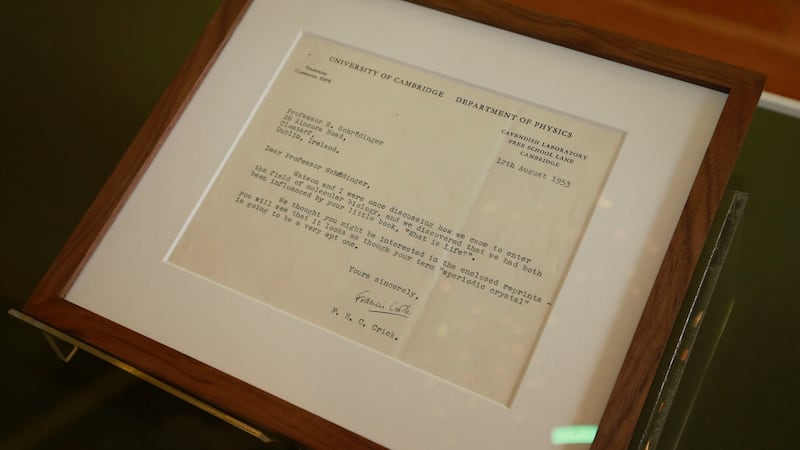A short letter written by Francis Crick, who discovered the structure of DNA with James Watson, delivered to a house in Clontarf, Dublin, in August 1953, has gone on public display for the first time.
In one sentence, Crick summed up the critical role theoretical physicist and Nobel prizewinner Erwin Schrödinger, the letter’s recipient, played in one of the most significant scientific breakthroughs of the 20th century months earlier.
It all stemmed from Schrödinger’s series of groundbreaking lectures entitled “What is Life?” delivered in Trinity College 10 years earlier, and issued in book form in 1944.

In the letter, delivered to Schrödinger’s then home on Kincora Road, just weeks after their discovery, Crick noted “Waston and I were once discussing how we came to enter the field of Molecular Biology, and we discovered we had both been influenced by your little book, ‘What is Life?’.”
Schrödinger's grandson, Prof Terry Rudolph, a leading theoretical physicist in his own right, said the letter had lessons for the way modern science is conducted.
The letter is being displayed at the Little Museum of Dublin to coincide with the 75th anniversary of Schrödinger’s lectures, courtesy of the Dublin Institute for Advanced Studies (DIAS) where he worked.
As an outspoken critic of the Nazi regime, Schrödinger was forced to flee his native Austria on the eve of the second World War, and was brought to Ireland by then taoiseach Éamon de Valera who was in the process of establishing DIAS, Ireland’s first high-level research institute.
Prof Rudolph, who is based at Imperial College London, attended an unveiling event at the museum on Wednesday, as part of a year-long programme to mark the anniversary.
“Having this letter on display means the public can better understand and engage with some of the major scientific achievements in which Ireland has played a significant role, often facilitated by the special and unique institution, DIAS,” he said.
Prof Rudolph said he only became aware of the letter in recent years. Seeing it, he said, “You realise science is done by real people”.
The letter indicated that when you are a scientist, you don’t know the impact of what you are working on when you are doing it, he said. This might take 30 years to emerge – though in his grandfather’s case it was within a short period of 10 years.
There was a lesson too for governments and funding agencies operating to five-year time-frames. Such was the modern approach to science, this kind of work might not be allowed in some research evaluations, he said.
Back then, he observed, scientists were also less specialised, and trained in a variety of disciplines. “If I tried to do this, I would be accused of the hubris of a physical scientist trying to do something in biology.”
DIAS chief executive Dr Eucharia Meehan said: “As our first director of theoretical physics, Schrödinger was a key figure in the development of DIAS. So it is important for us to commemorate the 75th anniversary of his seminal lectures, and his contribution to the discovery of DNA.”
She added: “We are delighted to have Prof Schrödinger’s grandson in Dublin at the opening of our programme of events and to have him meet with Ruairí Ó Cuív, whose maternal grandfather [Éamon de Valera] founded DIAS. Given that Ruairí’s father, Brian Ó Cuív, was also a professor of celtic studies at DIAS, it makes this meeting all the more special.”












